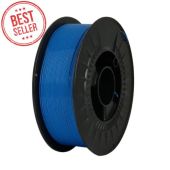PLA Drying Temp and Time: Best Practices for Industrial-Grade Results
Proper drying is critical to maintaining the performance of the filament in professional FDM 3D printing. Moisture absorption in PLA leads to a range of problems: visual print defects, mechanical weakness, and inconsistent extrusion. For companies producing high-tolerance components or prototypes, understanding the correct drying temp and time is essential for avoiding unnecessary material waste and downtime.
3D Trček brings over five decades of plastics experience and more than ten years of filament development. Their filaments are engineered with precision in mind, but even the highest-grade material needs proper drying if exposed to ambient humidity for extended periods.
Why PLA Must Be Dried Before Printing
PLA is a hygroscopic polymer, meaning it absorbs moisture from the air. Even a relatively short period in a high-humidity environment can cause internal water buildup in the filament. During printing, this moisture evaporates rapidly inside the hotend, leading to bubbling, inconsistent flow, and degraded print quality.
In precision applications such as aerospace tooling or automotive prototyping, these issues are unacceptable. Even minor surface defects or layer separation can compromise part performance. Moist filament can also cause nozzle clogs, stringing, and rough surface texture, which in turn increase post-processing time or require complete reprints.
Recommended Drying Temperature and Time
Most standard materials—including those supplied by 3D Trček—benefit from treatment at temperatures between 45°C and 55°C for four to six hours. This temperature range is low enough to avoid thermal deformation but high enough to drive out internal moisture.
Warning: Drying above 60°C should be avoided. PLA has a low glass transition temperature, and excessive heat can soften the filament, leading to oval-shaped spools or even sticking and fusing of adjacent filament layers.
Drying Equipment for Industrial Users
Professionals should use equipment capable of consistent temperature control. Standard kitchen ovens are usually not accurate enough and can overheat, especially during long drying cycles. Dedicated filament dryers or temperature-controlled dehydrators are preferred.
Recommended setups include:
- Filament dryers with digital temp control
- Food dehydrators modified for spool support
- Dry boxes with built-in heaters and real-time humidity monitoring are also a solid investment for teams handling large filament volumes daily.
Recognizing When Drying Is Needed
Sometimes drying is treated as a reactive step—only done when prints start to fail. However, moisture absorption can happen silently over just a few days of storage. You don’t always need bubbling or popping sounds to indicate wet filament. Subtle stringing, poor layer adhesion, or increased print times due to failed prints are also signs that drying may be necessary.
Instead of waiting for visible problems, it's best to include drying as part of the pre-printing routine if filament has been stored outside a controlled environment.
Storage Is Just as Important
Drying is only part of the process. How you store it afterward determines whether the filament remains effective. Most failures due to moisture come not from poor drying but from poor post-storage. Filament exposed to room air can reabsorb enough moisture to cause problems within 24 to 48 hours.
Filament should always be stored in airtight containers with desiccants after drying. For long-term use, vacuum-sealed bags with humidity indicators are ideal. Print farms and R&D environments benefit from dry boxes that allow printing directly from sealed storage, preventing moisture uptake during longer jobs.
Summary of Key Values
| Parameter | Recommended Value |
|---|---|
| Drying Temperature | 45°C–55°C |
| Drying Duration | 4–6 hours |
| Max Safe Temperature | 60°C |
| Safe Storage Humidity | Below 40% RH |
| Long-Term Storage | Airtight + desiccant |
Common Myths About PLA
Many professionals still assume that PLA does not require treatment at all, due to its lower moisture sensitivity compared to materials like nylon or PVA. While it's true PLA absorbs less water, it still suffers performance losses if exposed to humid air, especially in environments with fluctuating temperatures or high relative humidity.
Another myth is that a spool stored in a drawer or cabinet is protected. Unless the storage is fully airtight and includes an active drying agent, even closed cabinets can allow moisture buildup over time. Visual inspection of filament alone is not reliable — even seemingly dry filament can contain enough internal moisture to impact printing.
Understanding these misconceptions helps reinforce a more consistent approach to filament care.
Quality Assurance in Production Environments
For businesses that rely on batch production or low-volume manufacturing, drying and storage should be part of a documented quality control process. Each spool should be tracked for storage duration, environmental exposure, and drying cycles. This helps eliminate variables in print consistency and supports traceability in demanding applications like end-use part production or regulatory-compliant prototyping.
Integrating drying logs or material handling protocols into your workflow will support better outcomes. Teams working across shifts or departments benefit from having clear, enforced standards that ensure every spool enters the printer in a dry, print-ready state.
Final Thoughts
Professionals working with advanced filaments—like those developed by 3D Trček—should treat the process as a repeatable, essential step in their quality control workflow. Combined with airtight storage practices, it ensures consistent output and eliminates common moisture-related issues that can disrupt production.
; ?>) Shop PLA Filament
Shop PLA Filament


Please complete your information below to login.
Bejelentkezés
Új fiók létrehozása